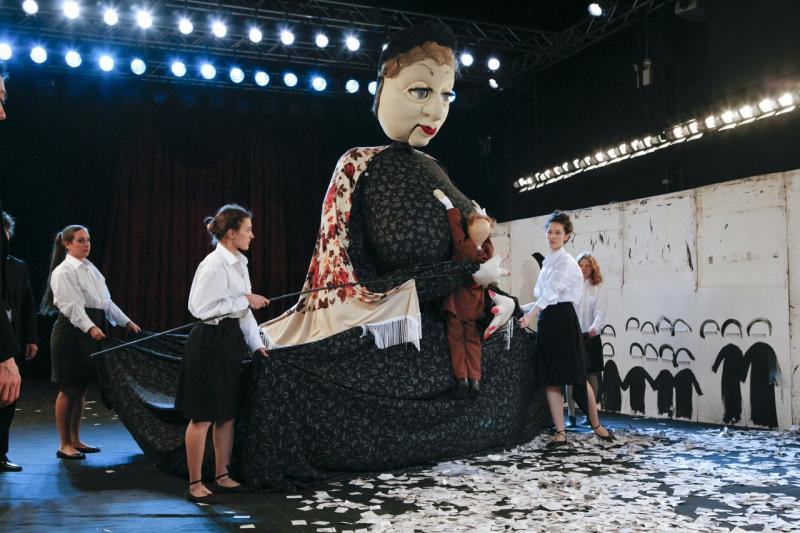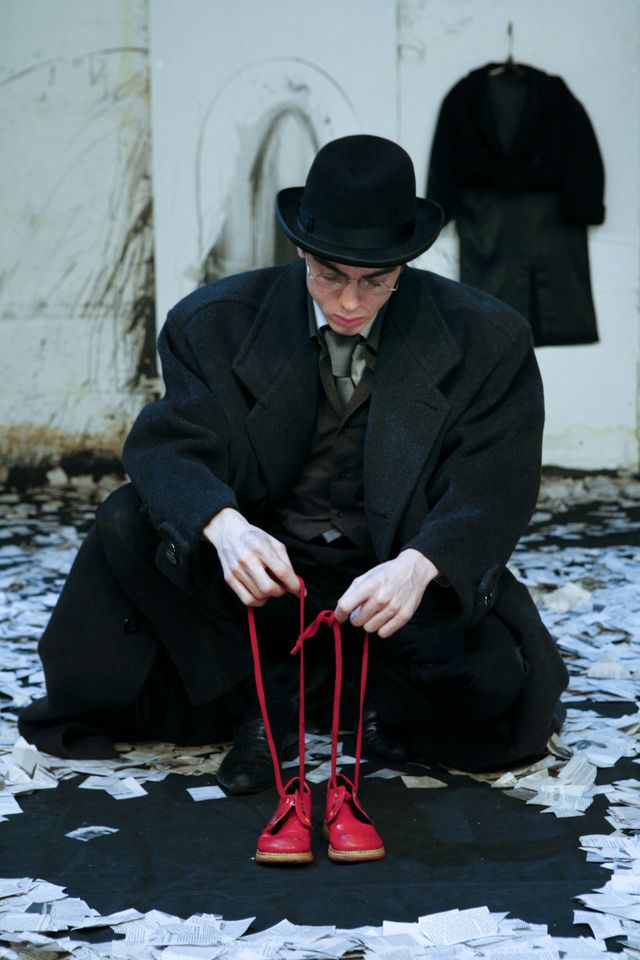Opus No 7, Corn Exchange, Brighton | reviews, news & interviews
Opus No.7, Corn Exchange, Brighton
Opus No.7, Corn Exchange, Brighton
Brighton Festival opener showcases cutting-edge Russian theatre

The UK premiere of Dmitry Krymov’s Opus No.7 begins at 5pm. When it finishes two and half hours later, a sun-dappled evening is bustling with the opening weekend of the Brighton Festival. At a nearby pub friends ask, “What was it like? What was it about?” For once I am lost for words. Describing Opus No.7 is akin to conveying an emotionally moving dream which, laid out prosaically, becomes gibberish.
Krymov is the toast of Moscow’s theatrical avant-garde because he’s not only completely out there, he’s also popular. His uniquely mischievous, surrealist approach to Chekhov and Shakespeare, among much else, has seen his reputation bloom both at home and abroad. Opus No.7 is really two pieces, each around an hour long. The first, Genealogy, is themed, broadly speaking, around the tragedy of the European Jewry in the first half of the 20th century. Krymov approaches the subject as a set designer and an artist (he once left theatre for a decade to become a successful exhibiting painter). The audience arrives to take tiered seats in a long row, facing a wall of white boards. A young, heavily pregnant woman in a giant greatcoat is buffing and polishing everything, including the shoes of audience members. She turns out to be Maria Smolnikova, Opus No.7’s lead actress and a ringer for the young Juliette Binoche.
 When the production begins her buffer handle becomes a radio aerial and the business end is hauled off to become her dress. She is joined by fellow actors, the men in shabby evening wear and the women in loose Greco-Roman dresses, but the white wall of boards is, perhaps, the true star. Through it arms and legs cut their way, actresses appear and a notable explosive highlight of Genealogy comes when the actors, in a line, throw tubs of black paint at it, then craft the splatter-patterns into silhouettes of Hassidic Jews. These later explode, cannoning thousands of ticker-tape newspaper squares out over the audience. This shower, it becomes clear, represents the masses lost in the Holocaust. The actors perform routines among them, reading out enigmatic phrases and Jewish names, their words translated via two screens of surtitles. The imagery of the Holocaust is never far – the wall spews out a mass of children’s shoes at one point, at another glasses pop through it, both recalling the contents of the warehouses at Auschwitz. Projected film is also used, an SS officer sinisterly passing along the wall, mutating into a Soviet commissar, hinting at Stalin’s anti-semitic hysteria of the early 1950s.
When the production begins her buffer handle becomes a radio aerial and the business end is hauled off to become her dress. She is joined by fellow actors, the men in shabby evening wear and the women in loose Greco-Roman dresses, but the white wall of boards is, perhaps, the true star. Through it arms and legs cut their way, actresses appear and a notable explosive highlight of Genealogy comes when the actors, in a line, throw tubs of black paint at it, then craft the splatter-patterns into silhouettes of Hassidic Jews. These later explode, cannoning thousands of ticker-tape newspaper squares out over the audience. This shower, it becomes clear, represents the masses lost in the Holocaust. The actors perform routines among them, reading out enigmatic phrases and Jewish names, their words translated via two screens of surtitles. The imagery of the Holocaust is never far – the wall spews out a mass of children’s shoes at one point, at another glasses pop through it, both recalling the contents of the warehouses at Auschwitz. Projected film is also used, an SS officer sinisterly passing along the wall, mutating into a Soviet commissar, hinting at Stalin’s anti-semitic hysteria of the early 1950s.
If Genealogy is a mind-boggling art event, full of surprises that make the viewer rethink how theatrical points can be made while treating its subject with dignity, the second half, Shostakovich, tethers its visual extravagance more firmly to a specific tale, that of the composer of the title, a man whose life and art were inextricably linked to the ideas and oppressions of the Soviet era. The performance starts with actor-stagehands sanding and jigsawing a rickety wooden frame that looks to be the bare skeleton of a grand piano. Played by the petite Smolnikova, wearing his iconic Harry Potter-ish glasses and a suit, Shostakovich is chased about and nurtured by a superb 15-foot puppet matron - Mother Russia - with blinking eyes and gigantic boobs, a routine that’s both funny and touching. Following an acrobatic routine she/he becomes one with – even trapped by - the piano, a scene of machine workshop theatre that recalls the performances of industrialist band Einstürzende Neubauten. Mother Russia eventually changes into Stalin with a smaller puppet Politburo and, accompanied by surtitled chunks of Shostakovich talking his way round his own oppression and swelling chapters from his Leningrad Symphony, as well the gloomier Second Piano Trio, the performance, which includes further extensive surreal acrobatics, seems to represent the composer being hemmed in by the state, climaxing in a fantastic extravaganza best described as a multiple metal piano bumper car rally, a vision as loud and magnificent as it is eye-boggling.
Krymov’s Opus No.7 does something so visual with theatre that, even when the brain doesn’t entirely understand the wider conceptual implications, the event itself fascinates. Despite the dark themes, everything is lathered in unlikely humour. Opus No.7 rarely lets its extreme artistic nature drift into self-indulgence and thus keeps doubters onside, a circus of ideas that leaves the viewer reeling.
Overleaf: watch a minute of clips from Opus No.7
The future of Arts Journalism
You can stop theartsdesk.com closing!
We urgently need financing to survive. Our fundraising drive has thus far raised £49,000 but we need to reach £100,000 or we will be forced to close. Please contribute here: https://gofund.me/c3f6033d
And if you can forward this information to anyone who might assist, we’d be grateful.

Subscribe to theartsdesk.com
Thank you for continuing to read our work on theartsdesk.com. For unlimited access to every article in its entirety, including our archive of more than 15,000 pieces, we're asking for £5 per month or £40 per year. We feel it's a very good deal, and hope you do too.
To take a subscription now simply click here.
And if you're looking for that extra gift for a friend or family member, why not treat them to a theartsdesk.com gift subscription?
more Theatre
 Macbeth, RSC, Stratford review - Glaswegian gangs and ghoulies prove gripping
Sam Heughan's Macbeth cannot quite find a home in a mobster pub
Macbeth, RSC, Stratford review - Glaswegian gangs and ghoulies prove gripping
Sam Heughan's Macbeth cannot quite find a home in a mobster pub
 The Line of Beauty, Almeida Theatre review - the 80s revisited in theatrically ravishing form
Alan Hollinghurst novel is cunningly filleted, very finely acted
The Line of Beauty, Almeida Theatre review - the 80s revisited in theatrically ravishing form
Alan Hollinghurst novel is cunningly filleted, very finely acted
 Wendy & Peter Pan, Barbican Theatre review - mixed bag of panto and comic play, turned up to 11
The RSC adaptation is aimed at children, though all will thrill to its spectacle
Wendy & Peter Pan, Barbican Theatre review - mixed bag of panto and comic play, turned up to 11
The RSC adaptation is aimed at children, though all will thrill to its spectacle
 Hedda, Orange Tree Theatre review - a monument reimagined, perhaps even improved
Scandinavian masterpiece transplanted into a London reeling from the ravages of war
Hedda, Orange Tree Theatre review - a monument reimagined, perhaps even improved
Scandinavian masterpiece transplanted into a London reeling from the ravages of war
 The Assembled Parties, Hampstead review - a rarity, a well-made play delivered straight
Witty but poignant tribute to the strength of family ties as all around disintegrates
The Assembled Parties, Hampstead review - a rarity, a well-made play delivered straight
Witty but poignant tribute to the strength of family ties as all around disintegrates
 Mary Page Marlowe, Old Vic review - a starry portrait of a splintered life
Tracy Letts's Off Broadway play makes a shimmeringly powerful London debut
Mary Page Marlowe, Old Vic review - a starry portrait of a splintered life
Tracy Letts's Off Broadway play makes a shimmeringly powerful London debut
 Little Brother, Soho Theatre review - light, bright but emotionally true
This Verity Bargate Award-winning dramedy is entertaining as well as thought provoking
Little Brother, Soho Theatre review - light, bright but emotionally true
This Verity Bargate Award-winning dramedy is entertaining as well as thought provoking
 The Unbelievers, Royal Court Theatre - grimly compelling, powerfully performed
Nick Payne's new play is amongst his best
The Unbelievers, Royal Court Theatre - grimly compelling, powerfully performed
Nick Payne's new play is amongst his best
 The Maids, Donmar Warehouse review - vibrant cast lost in a spectacular-looking fever dream
Kip Williams revises Genet, with little gained in the update except eye-popping visuals
The Maids, Donmar Warehouse review - vibrant cast lost in a spectacular-looking fever dream
Kip Williams revises Genet, with little gained in the update except eye-popping visuals
 Ragdoll, Jermyn Street Theatre review - compelling and emotionally truthful
Katherine Moar returns with a Patty Hearst-inspired follow up to her debut hit 'Farm Hall'
Ragdoll, Jermyn Street Theatre review - compelling and emotionally truthful
Katherine Moar returns with a Patty Hearst-inspired follow up to her debut hit 'Farm Hall'
 Troilus and Cressida, Globe Theatre review - a 'problem play' with added problems
Raucous and carnivalesque, but also ugly and incomprehensible
Troilus and Cressida, Globe Theatre review - a 'problem play' with added problems
Raucous and carnivalesque, but also ugly and incomprehensible
 Clarkston, Trafalgar Theatre review - two lads on a road to nowhere
Netflix star, Joe Locke, is the selling point of a production that needs one
Clarkston, Trafalgar Theatre review - two lads on a road to nowhere
Netflix star, Joe Locke, is the selling point of a production that needs one

Add comment